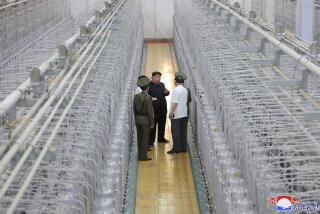Speculation grows over Syria site
- Share via
BEIRUT — An investigation into a remote Syrian site bombed by Israel 14 months ago has provided no conclusive answers so far, but sparked speculation about the source of trace amounts of radioactive material found at the site.
A report published Wednesday by the International Atomic Energy Agency said satellite imagery from the location near Dair Alzour suggested that the construction site “appears to have been similar” to the layout of a nuclear reactor.
Syria and Iran have both failed to cooperate fully with international inspectors, the U.N. agency said in a pair of reports delivered to its governing board. Tehran is slowly but steadily increasing its stockpile of enriched uranium and preparing thousands more machines to ramp up its nuclear capacity, which Iran insists is only meant to produce energy.
Syria denies having a nuclear program. U.S. intelligence officials this year briefed Congress about the site, which they said was a nuclear reactor modeled after one in North Korea. Such reactors produce weapons-grade plutonium, which can be used as fissile material in a nuclear bomb. The IAEA’s report may damage the credibility of Syria, which has claimed the locale was an unused military building.
“While it cannot be excluded that the building in question was intended for non-nuclear use, the features of the building . . . are similar to what may be found in connection with a reactor site,” the report said.
The agency said it had no luck gaining access to three other sites it wanted to inspect. Instead, the report said, satellite images showed “landscaping activities and the removal of large containers” shortly after access was requested.
But no one could explain the presence of a “significant number” of uranium particles “produced as a result of chemical processing,” the report said.
Diplomats first reported the existence of the uranium last week. Syrian officials have said that not even U.S. officials claim that they were already operating a plutonium plant.
“The only explanation for the presence of these modified uranium particles is that they were contained in the missiles dropped from the Israeli planes,” the report said.
But officials close to the IAEA said the uranium samples found were not the depleted type used in some weapons and have few practical applications. Nor do they match any Syrian uranium samples previously declared to the IAEA. Nor are they compatible with the reactor suspected of being planned for the site.
The agency plans to press Israel to release information about the weapons used.
--
More to Read
Sign up for Essential California
The most important California stories and recommendations in your inbox every morning.
You may occasionally receive promotional content from the Los Angeles Times.










